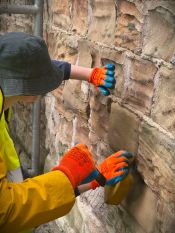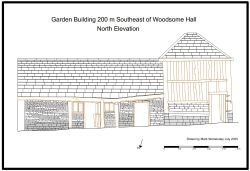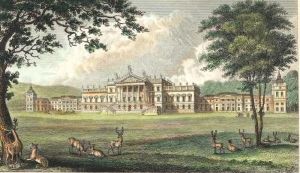Results of Plaster Analysis at Castle Dairy Kendal
Results of Plaster Analysis at Castle Dairy Kendal
Womersley’s after been instructed by Maysand and the NPS Group to analyse the mortar and plaster types on the ground floor walls of Castle Dairy in Kendal Cumbria have found that the most historic plasterwork appears to have been composed of a very lime binder rich mix. This plaster appears to have been made as a hot lime mix, with a significant amount of under burnt lime within it. The plaster was made by mixing locally produced quick lime with a small amount of washed river sand and leaving it to slake for a number of months, perhaps in a pit outside, to stop it slaking and popping on the walls, which could happen with premature use. Just before use it has had a lot of fine hair added to it, to in part compensate for the lack of well graded aggregate within it and interesting the addition of gypsum/plaster of Paris. It is not unusual to find gypsum in early plasters but it suggests parts of the building would have been finished with decorative plasterwork as many more wealthy homes of the later sixteenth and early seventeenth century were in the north of England.
It is hoped that these findings will help to guide restoration of plasterwork following serious flooding during last winter.
An important grade I listed building in the town The Dairy, which may have been a Dowry House linked to the Castle, dates back to the 14 Century. It was extensively remodelled c1560 for Anthony Garnett (numerous dated features have survived). It has a Central Hall with 2-storey cross-wings to either end and contains an exceptionally well-preserved interior.

Related Articles

The steps members of the Waterton’s Wall restoration team, with support from Mark Womersley, have been following to consolidate, conserve and repair this historic wall that represents the successful efforts of Charles Waterton to preserve the wildlife that lived on his estate near Wakefield in West Yorkshire.
1. Fill deep voids behind the wall’s facing stones with deep pointing work. The works involve …

Mark spent a day recording a historic timber-framed garden building at Woodsome Hall
Mark Womersley, as part of his voluntary work with the Yorkshire Vernacular Buildings Study Group, spent…

M Womersleys were delighted to offer a day of tutoring to those who attended the Wentworth Woodhouse Working Party
M Womersleys were delighted to offer a day of tutoring to those who attended the Wentworth Woodhouse…